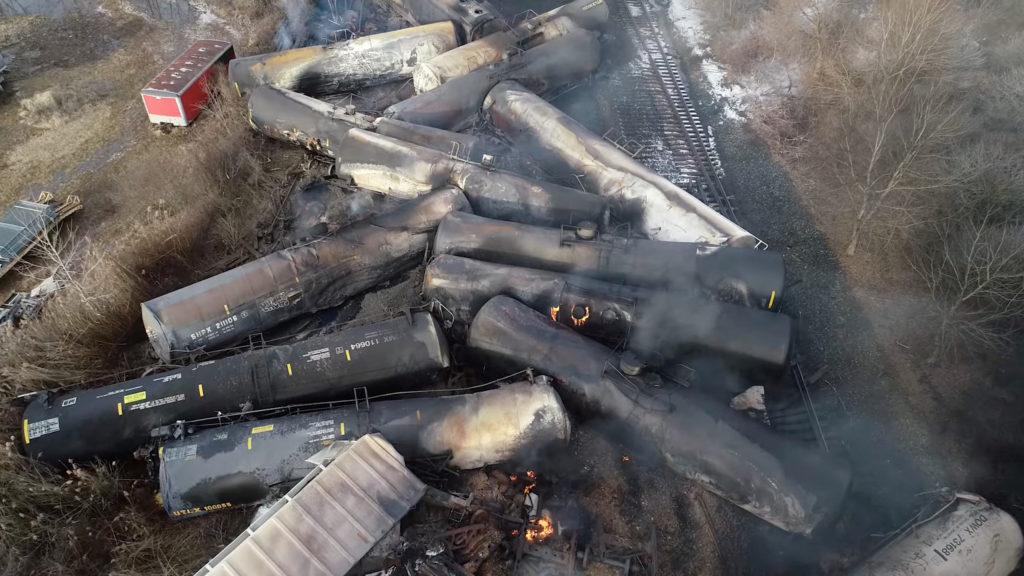Ohio Train Derailment: The Persistence Of Toxic Chemicals In Buildings

Table of Contents
Contamination Pathways: How Toxic Chemicals Entered Buildings
The release of vinyl chloride and other volatile organic compounds (VOCs) during the derailment created multiple pathways for contamination to infiltrate residential and commercial buildings.
Airborne Dispersion: The Invisible Threat
The initial explosion and subsequent burning of vinyl chloride created a massive plume of airborne contaminants. This plume, carried by wind, infiltrated buildings through various routes:
- Vapor Intrusion: Volatile chemicals like vinyl chloride can penetrate building foundations and enter living spaces through cracks and gaps in the structure. This process, known as vapor intrusion, is particularly concerning for buildings close to the derailment site.
- Wind Direction and Dispersion: The prevailing wind direction at the time of the derailment significantly influenced the spread of the chemical plume, impacting the extent of airborne contamination in different areas. Data on wind patterns during the event is crucial in assessing the risk profile of various buildings.
- Long-Range Transport: While the concentration diminishes with distance, airborne chemicals can travel significant distances, potentially contaminating buildings further away from the immediate impact zone. Studies are needed to determine the full extent of this long-range transport.
Surface Contamination: Direct Contact and Secondary Spread
Direct contact with contaminated soil or water served as another primary route for chemical contamination:
- Tracking Contaminants: Individuals and vehicles traveling through contaminated areas could have inadvertently tracked chemicals into buildings on their shoes, tires, and clothing.
- Rain and Runoff: Rainfall and surface water runoff could have transported chemicals from the derailment site to nearby buildings, contaminating surfaces and potentially entering basements or lower levels.
- Adhesion Properties: The adhesion properties of certain chemicals, such as those released in the derailment, determine their tendency to stick to various surfaces. Porous materials like concrete and wood are especially susceptible to absorbing and retaining these contaminants.
Water Contamination: A Hidden Danger
Groundwater and surface water sources in the vicinity of the derailment may have been compromised, posing a risk of contamination entering building water supplies:
- Drinking Water: The potential for contaminated water sources to affect drinking water supplies requires immediate investigation and remediation, if necessary.
- Leaching into Water Sources: Chemicals from contaminated soil can leach into groundwater and surface water sources, contaminating wells and other water bodies. This poses a persistent threat to buildings that rely on these water sources.
- Indoor Plumbing Systems: Contaminated water can enter building plumbing systems, exposing residents to harmful chemicals through various uses, including showering and dishwashing.
Types of Chemicals and Their Long-Term Effects
The Ohio train derailment released a cocktail of toxic chemicals, each posing unique long-term health risks.
Vinyl Chloride and its Persistence: A Serious Concern
Vinyl chloride, a known carcinogen, is particularly concerning due to its persistence:
- Health Risks: Exposure to vinyl chloride is linked to an increased risk of various cancers, including liver cancer, as well as liver damage and other health issues.
- Half-Life and Persistence: The half-life of vinyl chloride in different materials varies, indicating its potential to remain in the environment and buildings for an extended period. This long persistence necessitates long-term monitoring and remediation efforts.
- Remediation Challenges: The removal of vinyl chloride from contaminated materials can be challenging and expensive, requiring specialized techniques and expertise.
Other Toxic Chemicals: A Complex Mixture
Beyond vinyl chloride, other toxic chemicals released during the derailment include:
- Butyl Acrylate: This chemical can cause skin and respiratory irritation, and potentially more serious health problems with prolonged exposure.
- Ethylhexyl Acrylate: Similar to butyl acrylate, this chemical can cause skin and eye irritation.
- Ethylene Glycol Monobutyl Ether: This chemical can cause skin irritation, headaches, and dizziness.
Each chemical's unique properties and health effects demand careful evaluation and appropriate remediation strategies. The combined presence of multiple toxins further complicates the situation and necessitates comprehensive testing and analysis.
Testing and Remediation Strategies for Contaminated Buildings
Effective remediation necessitates a two-pronged approach: accurate testing to identify the extent of contamination, followed by appropriate remediation techniques.
Identifying Contamination: Accurate Assessment is Crucial
Accurate identification of contamination is essential for targeted and effective remediation:
- Air Sampling: Air samples from inside and outside buildings can reveal the presence and concentration of volatile organic compounds.
- Surface Sampling: Swabbing or other sampling techniques can be used to test building surfaces for the presence of non-volatile chemicals.
- Professional Expertise: Proper sampling and analysis require specialized expertise and equipment to ensure accurate and reliable results. Working with experienced environmental professionals is paramount.
Remediation Techniques: Removing or Mitigating the Threat
Numerous techniques are available for removing or mitigating chemical contamination in buildings:
- Air Scrubbing: Specialized air filtration systems can remove volatile organic compounds from the air.
- Surface Cleaning: Contaminated surfaces may be cleaned using appropriate techniques and detergents.
- Material Removal/Replacement: In cases of severe contamination, removal and replacement of affected materials may be necessary. This is often a costly and extensive process.
The choice of remediation techniques depends on the type and extent of contamination, the building materials, and the budget available. A comprehensive remediation plan should always be developed by qualified professionals.
Conclusion: Protecting Communities from Long-Term Threats
The Ohio train derailment highlights the devastating and long-lasting consequences of chemical spills, emphasizing the urgent need to address the lingering presence of Ohio Train Derailment toxic chemicals in buildings. Thorough testing and appropriate remediation strategies are vital to protect residents' health and safety. Continued monitoring and research are essential to fully understand the long-term implications and to develop effective preventative measures. We must advocate for stricter regulations, improved safety standards, and increased transparency to prevent future incidents and safeguard our communities from such devastating environmental catastrophes. If you suspect your building may be affected by the Ohio train derailment, seek professional testing and remediation services immediately to protect your health and well-being. Learn more about available resources and advocate for continued support for those affected by this ongoing environmental crisis.

Featured Posts
-
 Suri Cruise Tom Cruises Special Postpartum Act
May 12, 2025
Suri Cruise Tom Cruises Special Postpartum Act
May 12, 2025 -
 The Next Pope Examining The Leading Candidates To Succeed Francis
May 12, 2025
The Next Pope Examining The Leading Candidates To Succeed Francis
May 12, 2025 -
 Manon Fiorots Journey Overcoming Early Setback For Ufc Success
May 12, 2025
Manon Fiorots Journey Overcoming Early Setback For Ufc Success
May 12, 2025 -
 Voice Assistant Creation Open Ais 2024 Developer Event Highlights
May 12, 2025
Voice Assistant Creation Open Ais 2024 Developer Event Highlights
May 12, 2025 -
 26 Eama Tfsl Twm Krwz Wana Dy Armas Hl Hdha Ywthr Ela Elaqthma
May 12, 2025
26 Eama Tfsl Twm Krwz Wana Dy Armas Hl Hdha Ywthr Ela Elaqthma
May 12, 2025
Latest Posts
-
 Bayern Muenchens Toekomst Zonder Mueller Een Analyse Van Het Verlies
May 12, 2025
Bayern Muenchens Toekomst Zonder Mueller Een Analyse Van Het Verlies
May 12, 2025 -
 Mls
May 12, 2025
Mls
May 12, 2025 -
 Thomas Mueller Vertrekt Het Bittere Einde Van Een Bayern Legende
May 12, 2025
Thomas Mueller Vertrekt Het Bittere Einde Van Een Bayern Legende
May 12, 2025 -
 Transfer Antoan Baroan V Ludogorets Pod Naem
May 12, 2025
Transfer Antoan Baroan V Ludogorets Pod Naem
May 12, 2025 -
 Antoan Baroan E Novo Poplnenie V Ludogorets
May 12, 2025
Antoan Baroan E Novo Poplnenie V Ludogorets
May 12, 2025
